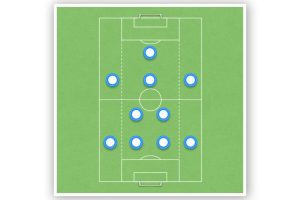Tactical Periodization: A Comprehensive Guide
Tactical Periodization is a training methodology that has been widely adopted and implemented by football coaches worldwide. It was developed around 35 years ago by Vítor Frade, a sports science professor from Porto University in Portugal. Since its creation, it has become one of the most popular and effective training methodologies in football.
As a coach, I have found Tactical Periodization to be a highly effective approach to training my players. The key tenet of Tactical Periodization is that training should never separate the physiological, tactical, technical, and psychological elements of the game. Instead, it integrates all these elements into a cohesive training program that prepares players for the demands of the game.
| Key Points |
|---|
| Tactical Periodization is a training methodology developed by Vítor Frade |
| It integrates the physiological, tactical, technical, and psychological elements of the game into a cohesive training program |
| Tactical Periodization has been widely adopted and implemented by football coaches worldwide |
The Tactical Periodization Method
The Tactical Periodization Methodology is a periodization method that has been widely adopted and implemented by coaches worldwide. It was developed around 35 years ago by Vítor Frade, a sports science professor from the University of Porto in Portugal. The Tactical Periodization Methodology is based on the idea that all training should be driven by tactical training. This means that coaches should focus on improving all other attributes such as technical, conditioning, and decision making at the same time, within every single tactical practice.
The Four Moments of the Game
The Tactical Periodization Methodology is based on the four moments of the game:
| Moment | Description |
|---|---|
| 1 | Transition to Defense |
| 2 | Defensive Organization |
| 3 | Transition to Offense |
| 4 | Offensive Organization |
According to the Tactical Periodization Methodology, coaches divide their tactical periodization training into four parts, according to the tactical context of the match. Each part is designed to improve the team’s performance in one of the four moments of the game. By doing this, coaches ensure that their team is always prepared tactically for any game situation.
The Tactical Periodization Methodology is based on a set of tactical principles that are used to create these training sessions. These principles of play are trained in isolation and then combined to create training sessions that are harder than a game. The aim is to develop players who have a deep understanding of their positional roles and can make better decisions on the field.
The Tactical Periodization Methodology is a way of playing that is developed throughout the season. It is not just a set of drills or exercises that are trained in isolation. Instead, it is a whole training process that is designed to develop players in a specific way. The Tactical Periodization Methodology is based on periodization principles that ensure that the training load is appropriate for the technical and tactical demands of the game.
The Tactical Periodization Methodology was developed by Vítor Frade in the simplest form possible. It is based on the idea that players should be trained to rapidly alter their on-field behavior in response to changes of direction in the game. The aim is to develop players who can rapidly alter their on-field behavior in response to changes of direction in the game.
The Tactical Periodization Methodology is always planned and researched so that we create training sessions that are harder than a game. This helps you accelerate your players’ development and ensures that they are always prepared tactically for any game situation.
Training Sessions
In tactical periodization, training sessions are designed to improve the team’s tactical understanding of their positional roles and responsibilities. Every training must be modeled around the tactical game, and every training must have a specific purpose that contributes to the whole training process.
Training in the Specific
Training in the specific is a fundamental principle of tactical periodization. It involves simulating game situations in training sessions that are harder than the actual game. This approach helps the team to play with greater intensity and focus during the actual game.
For example, when I was working with my team, we would simulate a game situation where we were down by a goal with only 10 minutes remaining. This would help the team to learn how to press and attack with greater intensity while maintaining their defensive shape.
The Four Parts of Tactical Periodization Training
The tactical periodization training model is divided into four parts: technical, tactical, physical, and mental. Each part is essential to the whole football training process.
| Part | Description |
|---|---|
| Technical | Improving the individual skills of the players such as passing, dribbling, and shooting. |
| Tactical | Improving the team’s understanding of their positional roles and responsibilities. |
| Physical | Improving the team’s physical fitness and endurance. |
| Mental | Improving the team’s mental toughness and ability to handle pressure situations. |
Every training week is designed to focus on one or more of these parts. For example, on the day after a match, we would focus on the physical part of the training to help the players recover from the previous game. On the other hand, during the mid-week training sessions, we would focus on the tactical and technical parts of the training to prepare for the upcoming game.
Jose Mourinho’s approach to tactical periodization involves breaking down the training sessions into small parts and then gradually building up to the whole training. This approach helps the players to learn and understand the tactical concepts in a step-by-step manner.
In conclusion, training sessions in tactical periodization are designed to improve the team’s tactical understanding of their positional roles and responsibilities. The training must be modeled around the tactical game, and every training must have a specific purpose that contributes to the whole training process. The four parts of tactical periodization training are technical, tactical, physical, and mental, and each part is essential to the whole football training process.
Conclusion
Throughout my research on Tactical Periodization, I have come to the conclusion that it is a highly effective and holistic approach to training and preparation for football teams. By integrating the physical, tactical, technical, and mental elements of the game, players are able to develop a deep understanding of the game and improve their overall performance.
One of the key benefits of Tactical Periodization is that it allows players to develop a high level of tactical intelligence. By focusing on the tactical aspects of the game during training, players are able to develop a deeper understanding of the game and make better decisions on the field. This is particularly important in high-pressure situations, where split-second decisions can make all the difference.
Another benefit of Tactical Periodization is that it helps players to develop a high level of physical fitness. By integrating the physical and tactical elements of the game, players are able to improve their endurance, strength, and speed, which can have a significant impact on their performance on the field.
| Key Points |
|---|
| Tactical Periodization is a holistic approach to training and preparation for football teams |
| It allows players to develop a high level of tactical intelligence |
| It helps players to develop a high level of physical fitness |
Overall, I believe that Tactical Periodization is an essential tool for any football coach or player who wants to take their game to the next level. By focusing on the key elements of the game and integrating them into training, players are able to develop a deep understanding of the game and improve their overall performance. Whether you are a professional footballer or a weekend warrior, Tactical Periodization can help you to achieve your goals and take your game to the next level.








